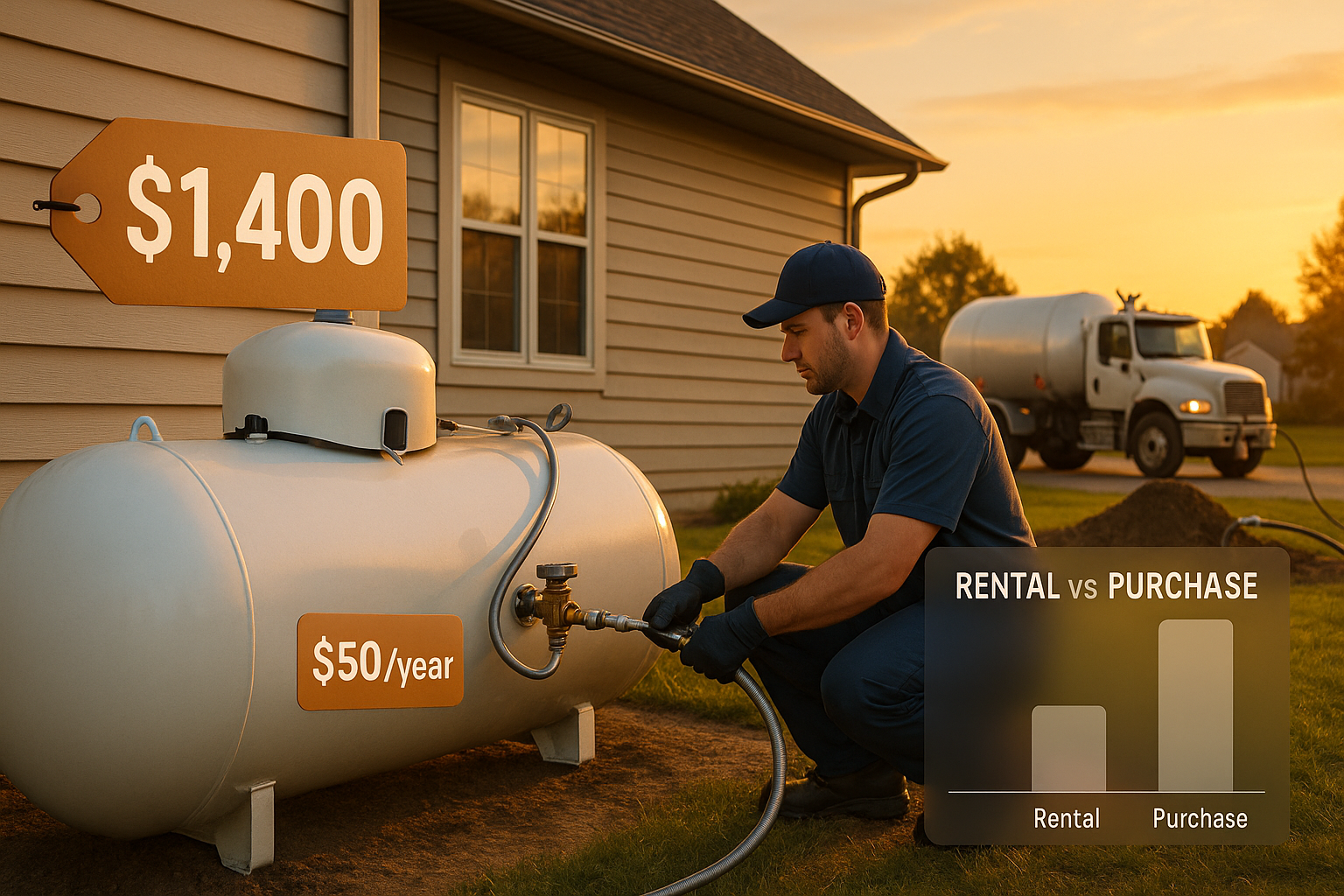Guide to Propane Tank Costs: Installation, Sizing, and Long-Term Expenses
Installing a propane tank is a major investment for homeowners who rely on propane for heating, cooking, or powering appliances. The total cost depends on tank size, installation type (aboveground vs. underground), location, and ongoing maintenance. Based on current market trends, the average homeowner pays between $600 and $2,500 for a standard aboveground installation, with an overall average of $1,400. However, larger tanks, underground installations, or challenging sites can push costs up to $5,500 or more.
This comprehensive guide walks you through every aspect of propane tank costs—from initial purchase and installation to long-term fuel and maintenance expenses—to help you make informed decisions that align with your budget and energy needs.
Comprehensive Cost Breakdown by Tank Size and Type
Propane tank prices vary widely depending on their capacity and whether they are installed aboveground or buried underground. Here’s a breakdown of typical costs for various sizes:
Tank Size and Capacity
Small Tanks (100–250 gallons)
Ideal for single appliances like water heaters or dryers:
- 100-gallon tank: $350–$800 (aboveground only)
- 250-gallon tank: $500–$1,200 (aboveground only)
These tanks are compact and affordable but not suitable for whole-house heating unless combined with other systems.
Whole-House Tanks (500–1,000 gallons)
Designed for homes using propane for central heating and multiple appliances:
- 500-gallon tank:
- Aboveground: $1,000–$2,000
- Underground: $1,500–$2,500
- 1,000-gallon tank:
- Aboveground: $1,500–$2,500
- Underground: $2,000–$5,500
These tanks are necessary for off-grid or rural homes where natural gas isn’t available.
Portable Tanks (15–100 pounds)
Used for grills, fire pits, generators, and outdoor heating:
- 20-pound tank: $40–$60
- 100-pound tank: $100–$150
These tanks are refillable and often rented from suppliers at low monthly rates.
Aboveground vs. Underground Installation
| Feature | Aboveground Tanks | Underground Tanks |
|---|---|---|
| Cost Range | $400–$3,500 | $1,500–$5,500 |
| Installation Time | 4–8 hours | 1–2 days |
| Pros | Lower cost, easy access, faster setup | Aesthetically pleasing, longer lifespan |
| Cons | Visible, weather-exposed, may need concrete pad | Higher cost, complex excavation, harder repairs |
Key Considerations:
- Aboveground tanks are best for temporary use, budget-conscious buyers, or areas with high water tables.
- Underground tanks offer better curb appeal and protection from elements but require professional installation and regular inspections.
Key Factors Influencing Installation Costs
Several variables affect the final price beyond the tank itself:
Labor and Preparation
- Labor Rates: $50–$150/hour, varying by region
- Excavation (for underground tanks): $50–$200 per cubic yard
- Concrete Pad (aboveground tanks): $50–$175
- Gas Line Installation: $250–$800 ($15–$25 per linear foot)
Permits and Compliance
- Permit Fees: $25–$150
- Safety Regulations: Tanks must be ≥10 feet from structures and ≤150 feet from delivery truck access roads
Additional Expenses
- Tank Removal:
- Aboveground: $100
- Underground: up to $1,500
- Annual Maintenance: $50–$75 for inspections
Long-Term Ownership Costs
Once installed, the real expense comes from fueling and upkeep.
Refilling Expenses
As of early 2025, the national average for propane is $2.59/gallon, though prices fluctuate based on region:
| Tank Size | Usable Capacity (80%) | Refill Cost @ $2.59/gal |
|---|---|---|
| 100 gal | 80 gal | $207 |
| 250 gal | 200 gal | $518 |
| 500 gal | 400 gal | $1,036 |
| 1,000 gal | 800 gal | $2,072 |
Note: Propane tanks are filled to only 80% of capacity to allow for expansion under heat.
Renting vs. Buying
Homeowners have two options:
- Renting:
- Annual fee: $150–$180
- Includes maintenance
- Locked into supplier pricing
- Buying:
- Higher upfront cost
- Freedom to choose fuel providers
- Better value over time, especially for long-term homeowners
Regional and Market Considerations
Geographical Variations
- Rocky Soil (New England): Excavation adds $200–$300
- Hurricane Zones (Southern U.S.): Anchoring increases costs
- Earthquake-Prone Areas (West Coast): Bracing required
Propane Price Trends
- Wholesale price as of July 2025: $0.72/gallon
- Retail prices vary due to delivery fees, taxes, and supplier markups
- Forecasted retail increase to $0.79/gallon within a year
Strategies to Reduce Costs
- Install During Off-Peak Season (Spring)
- Many installers offer discounts during slower months.
- Get Multiple Quotes
- Compare at least three licensed contractors for competitive pricing.
- Check for Incentives and Rebates
- Some states (e.g., Massachusetts) provide rebates up to $500 for switching from oil to propane.
- Opt for Aboveground Tanks
- Save thousands compared to underground installation.
- Consider Tank Ownership
- While renting is convenient, buying offers long-term savings and flexibility.
Critical Safety Note
DIY installation is not recommended for tanks over 100 gallons. Propane systems involve:
- Risk of gas leaks
- Fire hazards
- Code violations that void insurance coverage
Always hire licensed professionals to ensure safe, compliant installation.
Balancing Upfront and Lifetime Costs
Choosing the right propane tank involves balancing initial investment with long-term efficiency and safety. For small-scale use, a 100–250-gallon aboveground tank ($600–$1,200) may suffice. Whole-house heating typically requires a 500–1,000-gallon unit, with underground installations offering aesthetic benefits at a higher cost.
When planning your installation:
- Factor in regional fuel prices
- Account for maintenance and refill schedules
- Consider rental vs. ownership models
- Ensure all work complies with local codes and permits
Propane remains a reliable and cost-effective energy source for off-grid living when properly planned and professionally installed. For accurate quotes tailored to your home, consult certified installers via platforms like HomeAdvisor or Angi, and always verify licensing and insurance before hiring.
Final Tips
- Plan ahead: Install before winter to avoid peak demand surcharges
- Monitor propane levels to avoid emergency refills
- Keep records of inspections and maintenance for warranty and resale value
By making smart choices today, you can enjoy decades of efficient, clean, and safe propane energy.

